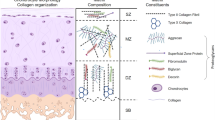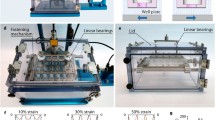Abstract
Efforts to minimize the sacrifice of laboratory animals have become a recent worldwide trend. This trend has triggered a number of studies toward developing effective methods to replace the animal experiments. In this study, we developed a biomimetic bioreactor system that simulates the movements of the human knee joint. The system consists of a knee-joint drive and a unit capable of culturing cells at the joint surface. The knee-joint drive is designed to apply dynamic stimulation similar to the real bending motion of the knee joint. We employed a commercial incubator for comparative evaluation and validation of our laboratory-made cell-culture unit mounted in a bioreactor. The results revealed that the ability of the proposed system in culturing cells was similar to that of the commercial incubator. The cell culture was evaluated by dividing the knee joint into zones according to the size of the stimulus. The results confirmed that the cell assessment stimulated by the knee-joint movement was two times higher than that having no stimulation. Overall, the study helped establish that the cell characteristics is more effective when an appropriate external stimulus is applied according to the target tissue. The study is also expected to form the basis for implementing an ex-vivo environment that can potentially replace animal and cadaver experiments in the future. In the future, follow-up studies will be conducted on the in-vivo environment and the characteristics of each organ and tissue for effective tissue regeneration.
Similar content being viewed by others
References
Z. Chunqiu, Z. Xizheng, W. Han, H. Daqing and G. Jing, Direct compression as an appropriately mechanical environment in bone tissue reconstruction in vitro, Med. Hypotheses, 67(6) (2006) 1414–1418.
P. Reher, N. I. Elbeshir, W. Harvey, S. Meghji and M. Harris, The stimulation of bone formation in vitro by therapeutic ultrasound, Ultrasound Med. Biol., 23(8) (1997) 1251–1258.
G. Vunjak-Novakovic, L. Meinel, G. Altman and D. Kaplan, Bioreactor cultivation of osteochondral grafts, Orthod Craniofac Res, 8(3) Aug (2005) 209–218.
Z. Y. Zhang et al., A biaxial rotating bioreactor for the culture of fetal mesenchymal stem cells for bone tissue engineering, Biomaterials, 30(14) May (2009) 2694–2704.
J. P. Vacanti and R. Langer, Tissue engineering: the design and fabrication of living replacement devices for surgical reconstruction and transplantation, Lancet, 354(1) Jul. (1999) SI32–34.
G. Jin, G. H. Yang and G. Kim, Tissue engineering bioreactor systems for applying physical and electrical stimulations to cells, J. Biomed. Mater. Res. B Appl. Biomater, 103(4) May (2015) 935–948.
H.-J. P. N.-K. Lee and K.-M. Lim, Reconstructed human skin and cornea models as alternative methods to animal tests, Journal of Alternatives to Animal Experiments, 8 (2014) 29–36.
G. Vunjak-Novakovic, K. O. Lui, N. Tandon and K. R. Chien, Bioengineering heart muscle: A paradigm for regenerative medicine, Annu. Rev. Biomed. Eng., 13 (2011) 245–267.
H. T. Au, I. Cheng, M. F. Chowdhury and M. Radisic, Interactive effects of surface topography and pulsatile electrical field stimulation on orientation and elongation of fibroblasts and cardiomyocytes, Biomaterials, 28(29) Oct. (2007) 4277–4293.
L. M. G. Vunjak-Novakovic, G. Altman and D. Kaplan, Bioreactor cultivationof osteochondral grafts, Orthidintics & Craniofacial Res., 8(3) (2005) 209–218.
D. Wendt, A. Marsano, M. Jakob, M. Heberer and I. Martin, Oscillating perfusion of cell suspensions through three-dimensional scaffolds enhances cell seeding efficiency and uniformity (in English), Biotechnology and Bioengineering, 84(2) (2003) 205–214.
D. W. S. Scaglione, S. Miggino, A. Papadimitropoulos, M. Fato, R. Quarto and I. Martin, Effects of fluid flow and calcium phosphate coating on human bone marrow stromal cells cultured in a defined 2D model system, Journal of Biomedical Materials Research Part A, 86 (2007) 411–419.
M. C. Qi, J. Hu, S. J. Zou, H. Q. Chen, H. X. Zhou and L. C. Han, Mechanical strain induces osteogenic differentiation: Cbfa1 and Ets-1 expression in stretched rat mesenchymal stem cells (in English), International Journal of Oral and Maxillofacial Surgery, 37(5) May (2008) 453–458.
D. Kaspar, W. Seidl, C. Neidlinger-Wilke, A. Beck, L. Claes and A. Ignatius, Proliferation of human-derived osteoblast-like cells depends on the cycle number and frequency of uniaxial strain (in English), Journal of Biomechanics, 35(7) Jul. (2002) 873–880.
C. Y. C. Huang, K. L. Hagar, L. E. Frost, Y. B. Sun and H. S. Cheung, Effects of cyclic compressive loading on chondrogenesis of rabbit bone-marrow derived mesenchymal stem cells (in English), Stem Cells, 22(3) (2004) 313–323.
O. Demarteau et al., Dynamic compression of cartilage constructs engineered from expanded human articular chondrocytes (in English), Biochemical and Biophysical Research Communications, 310(2), Oct. 17 (2003) 580–588.
P. F. Davies and S. C. Tripathi, Mechanical stress mechanisms and the cell. An endothelial paradigm, Circ. Res., 72(2) Feb. (1993) 239–245.
P. Angele et al., Cyclic hydrostatic pressure enhances the chondrogenic phenotype of human mesenchymal progenitor cells differentiated in vitro (in English), Journal of Orthopaedic Research, 21(3) May (2003) 451–457.
K. Shahin and P. M. Doran, Tissue engineering of cartilage using a mechanobioreactor exerting simultaneous mechanical shear and compression to simulate the rolling action of articular joints (in English), Biotechnology and Bioengineering, 109(4) Apr. (2012) 1060–1073.
G. E. Nugent-Derfus et al., Continuous passive motion applied to whole joints stimulates chondrocyte biosynthesis of PRG4, Osteoarthritis Cartilage, 15(5) May (2007) 566–574.
Y. S. Cho, B. S. Kim, H. K. You and Y. S. Cho, A novel technique for scaffold fabrication: SLUP (salt leaching using powder) (in English), Current Applied Physics, 14(3) Mar. (2014) 371–377.
B. M. Tymrak, M. Kreiger and J. M. Pearce, Mechanical properties of components fabricated with open-source 3-D printers under realistic environmental conditions (in English), Materials & Design, 58 (2014) 242–246.
D. K. M. I. D. Johnston, C. K. L. Tan and M. C. Tracey, Mechanical characterization of bulk Sylgard 184 for microfluidics and microengineering, Journal of Micromechanics and Microengineering, 24 (2014) 7.
J. Yang et al., Fabrication and surface modification of macroporous poly(L-lactic acid) and poly(L-lactic-co-glycolic acid) (70/30) cell scaffolds for human skin fibroblast cell culture (in English), Journal of Biomedical Materials Research, 62(3) (2002) 438–446.
J. H. P. I. H. Lee, S.-J. Lee, D.-W. Cho and S. S. Kan, Effects of mechanical stimulation for MC3T3-E1 cells using bioreactor, The Korean Society of Mechanical Engineers, 11 (2008) 1411–1414.
Author information
Authors and Affiliations
Corresponding authors
Additional information
Recommended by Associate Editor Young Hun Jeong
Hun-Jin Jeong received his B.S. and M.S. degrees in Mechanical Engineering from Wonkwang University in 2015 and 2017, respectively. His research interests include 3D printing technology and its application to tissue engineering such as bone, cartilage regeneration, and fabricated scaffold.
So-Jung Gwak received her Ph.D. degree in Chemical Engineering from Hanyang University in 2008. She is currently a Professor in Department of Chemical Engineering at Wonkwang University. The focus of her project is the development of drug delivery system and tissue engineering.
Young-Sam Cho received his Ph.D. degree in Mechanical Engineering from Korea advanced Institute of Science and Technology (KAIST) in 2004. He is currently a Professor in Department of Mechanical Design Engineering at Wonkwang University. His research interests include finite element analysis and its application to tissue engineering.
Seung-Jae Lee received his Ph.D. degree in Mechanical Engineering from the Pohang University of Science and Technology (POSTECH) in 2007. He is currently a Professor in Department of Mechanical Design Engineering at Wonkwang University. His research interests are on advanced manufacturing system and biomedical application.
Rights and permissions
About this article
Cite this article
Jeong, HJ., Gwak, SJ., Kang, NU. et al. Bioreactor mimicking knee-joint movement for the regeneration of tissue-engineered cartilage. J Mech Sci Technol 33, 1841–1850 (2019). https://doi.org/10.1007/s12206-019-0336-8
Received:
Revised:
Accepted:
Published:
Issue Date:
DOI: https://doi.org/10.1007/s12206-019-0336-8




